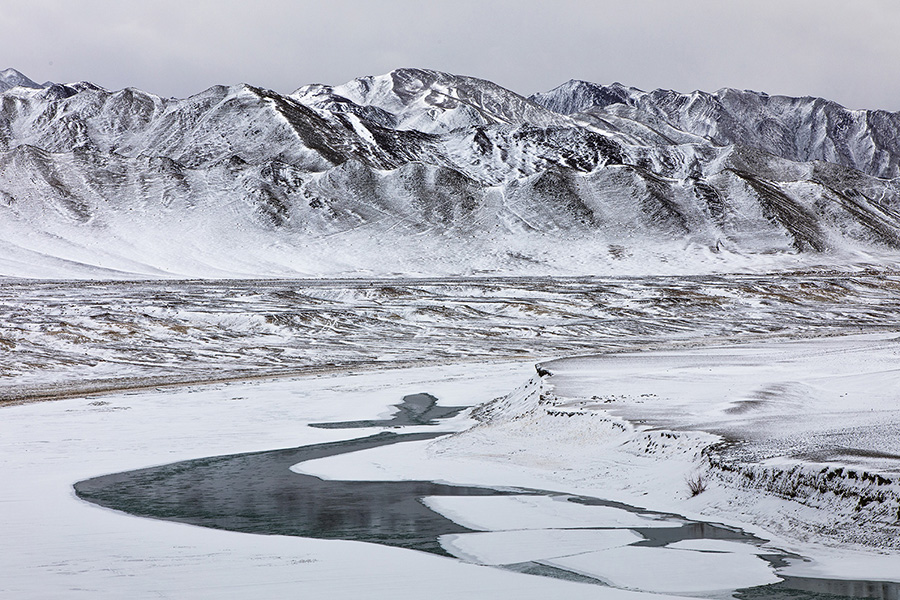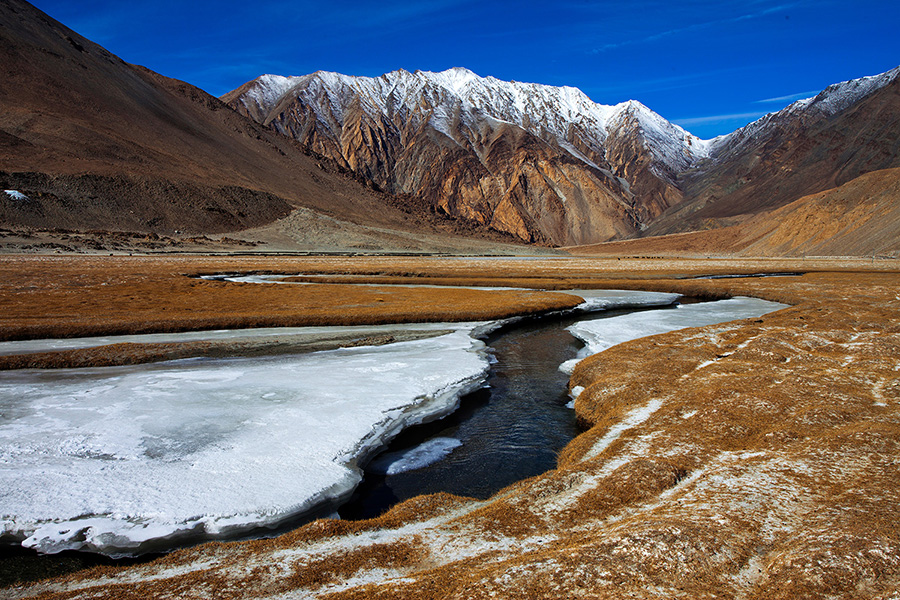11 Images of Winters in Ladakh — India’s ultimate landscape photography experience!
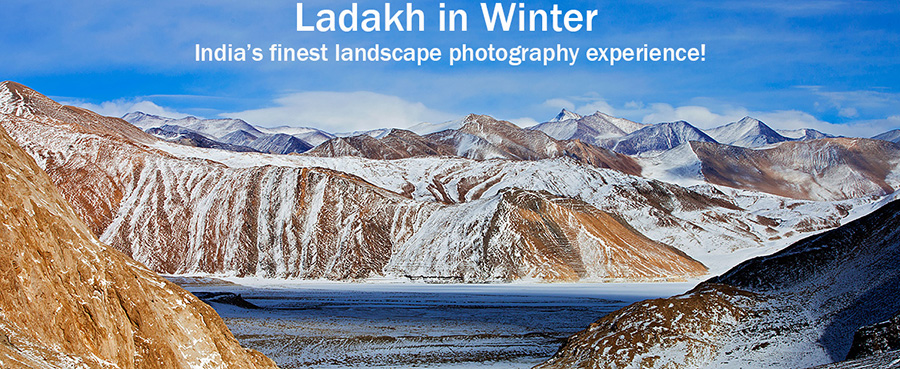
Here is a collection my images of winters in Ladakh, made over several visits in a span of about 7 years. Originally posted on medium.com – Winters in Ladakh — India’s ultimate landscape photography experience!

Powdery snow on the mountains over a frozen Pangong Tso Lake, in Ladakh during winters.
I first visited Ladakh exactly ten years ago. This was well before the region became every motor-cyclist’s ultimate destination, part of every traveller’s tick-off list and every holidaymaker’s check-in dream. In those days, tourists were in smaller numbers and Leh had more homes than guesthouses and hotels.
Every winter, we conduct a photography tour to see and capture the glorious landscapes of Ladakh. This is perhaps India’s ultimate landscape photography experience. Travel to the highlands of Ladakh in winter, when Ladakh is at its pristine best — with its snow-clad mountain landscapes, frozen lakes, resilient nomads with their herds of sheep and yaks and endless fields of snow. Explore photography on the roof of India on this mentored photography tour in a season when the earth is covered in a carpet of snow. See details and sign up today: A Snow-filled Winter in Ladakh — Photography Tour
The story is all different now. Ever since a block-buster Indian movie featured the landscapes of Ladakh eight years ago, it has become the go-to destination of hundreds of thousands of people every year. The region has been transformed from a quite mountainous escape to a bustling tourist town of German bakeries, pizza joints and mall-roads!
But all that ends when the summer season makes way to a cold frigid winter in Ladakh. After September, as the temperatures start falling rapidly, shutters are downed on the souvenir shops. Most hotels close for winter and taxi drivers stay home for a few months. But this is also the time when mountains are transformed through the magic of falling snow.
Earth changes colour from barren brown to a dazzling white. For landscape photography enthusiasts, this is an amazing time to be in Ladakh. It’s when you find the rivers turning from a muddy-brown to a deep blue slither surrounded thick icy-foamy white on either sides. It’s when the high-altitude lakes freeze, reflecting the sun rays with a sparkle and highlighting the air bubbles trapped in a thick layer of ice.
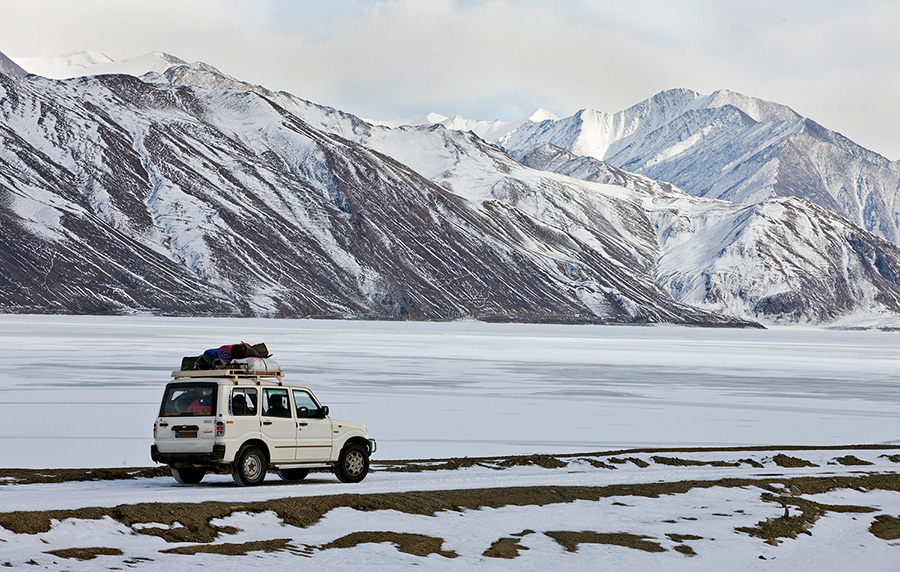
Travelling the snowy landscapes of Ladakh in winter… driving past Pangong Lake
As a landscape photographer, this is my small peace of heaven that calls for an annual pilgrimage. I have come back here year after year, finding diversity in winter weather each year. Sometimes it is so covered in snow that some regions may become inaccessible, while in other times I have seen a relatively dry season. Each of them have its own charm. But more often than not, you can see all possible forms: dry ground to powdery snow to a blanket of snow that varies in proportion from place to place.
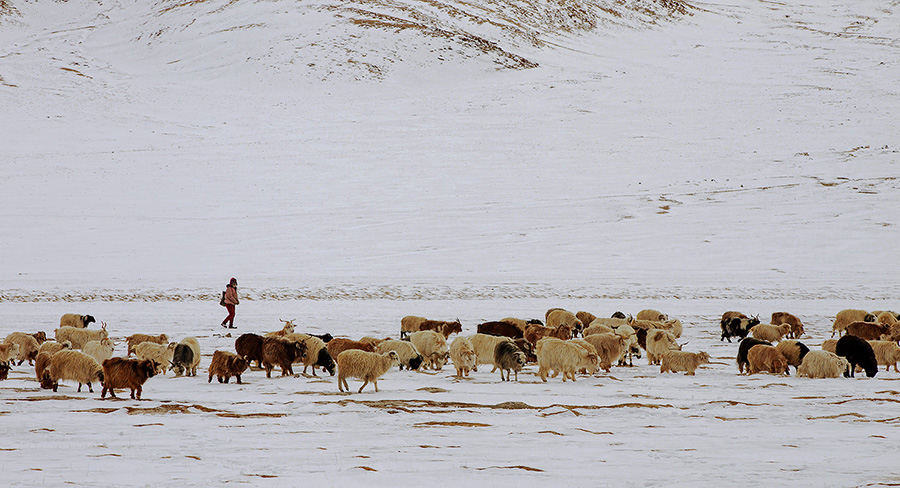
Sheep graze on small stubble of grass leftover from summer. In the highlands of Changthang during winters in Ladakh.
Up in the highlands of Changthang, where the altitudes can be 4,000m or higher, it’s normal to see the entire landscape covered in snow. The temperatures can fall to -25C or lower. It’s a wonder that the sheep and goats continue to live in this harsh climate, and survive by eating whatever little grass is left from the last summer. For these sheep and the shepherds, these winter days seem to be just normal times. Despite the cold, occasional blizzards and harsh weathers, they go out with the sheep day-after-day just like they would do on a balmy summer morning.
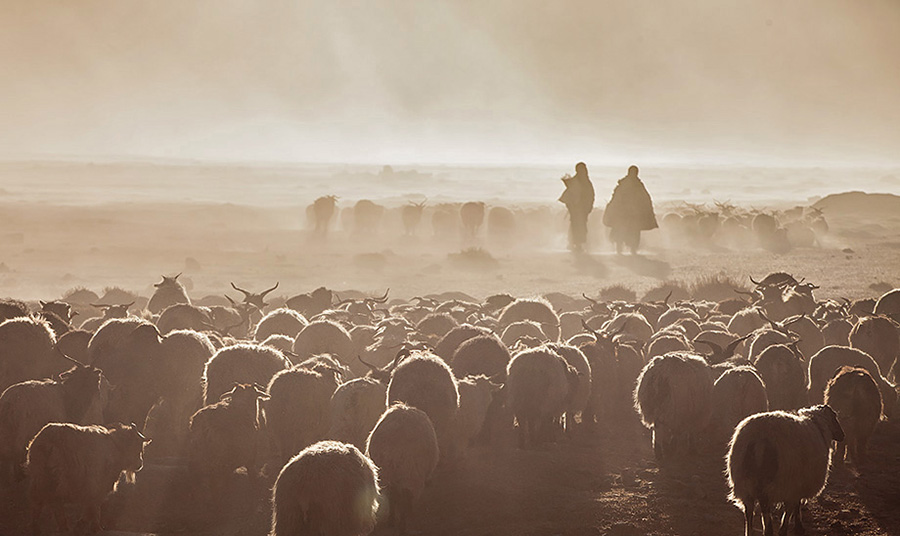
Changpa herders walking into the sunset… taking their herd back home on a winter evening in Ladakh.
On one winter when the precipitation was very little, the region still remained charming with its frozen lakes and streams. I witnessed a magical scene in the highlands of Changthang one evening. As our car slowly pulled across a curve, we saw dust kicking up in the horizon and immediately realized the magnitude of the force from the kicking hooves that pounded the earth a few thousand times in unison. Sun rays were scattered by the dust all over, obscuring the sun himself. As we slowly drove closer, we could now distinguish the individual figures of sheep from the blob of dust-cloud, and a shepherd or two directing the flock homewards. It was a magnificent display of a thousand energies working together in synchronicity to produce magic that can’t be created with a single entity.
I was hypnotized. We walked out of the car and swiftly walked behind the sheep and caught up with them in no time, and started following the spectacle as it moved. We must have walked a kilometer or two in the next ten minutes, utterly amazed in watching the unfolding play of light and the subsequent drama. At the time, I had forgotten all factors of environment that made our presence there difficult — the sub-zero winter weather of Ladakh that would make us yearn to be indoors and the rarefied air that keeps us slothful.
Driving along the valleys with small streams can be an exhilarating experience in the winters. Most of the streams are partially frozen, forming milky-foamy edges. The meandering streams often overflow into the valley floor, making interesting formations of alternating ice and grass in the landscape flanked by tall snow-peaks.
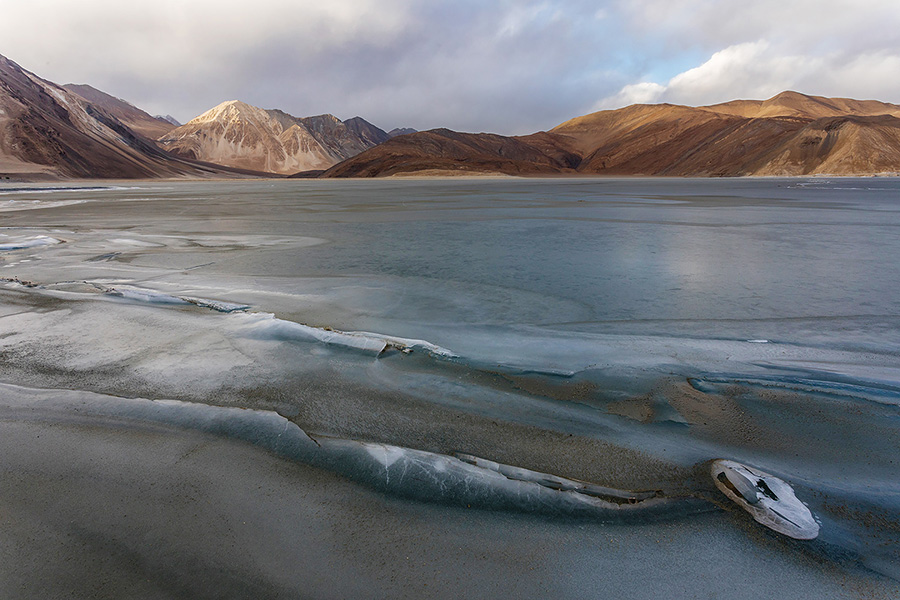
A nearly-frozen Pangong lake during winter in Ladakh.
In the highlands, the large lakes — Pangong Tso and Tso Moriri — are either frozen or in the process of freezing depending on how early do you visit. The frozen lakes sometimes form a layer of ice thick enough to drive cars. But on a not-so-cold winter, it may be risky to attempt a walk on the frozen lake surface.
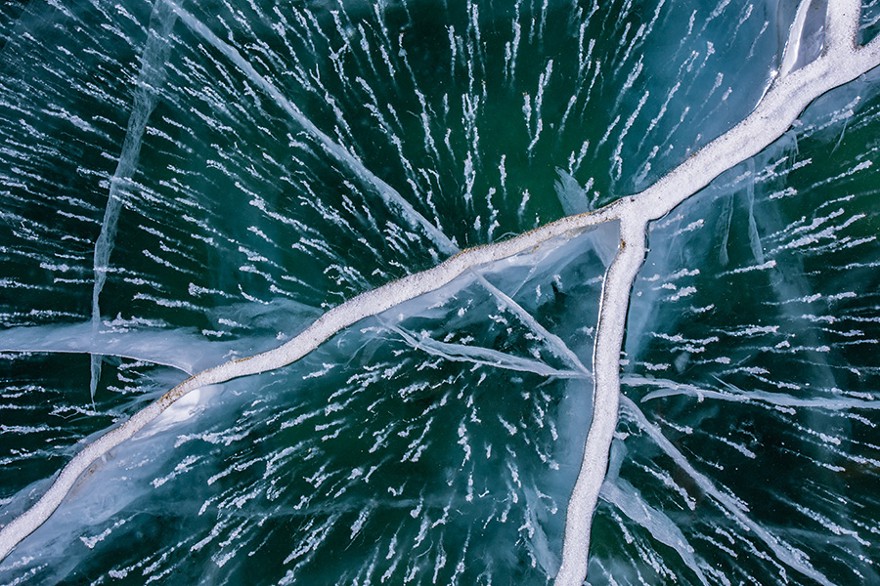
Bubbles of air trapped in the thick freeze of Tso Moriri Lake.
The Tso Moriri lake is located in a colder place compared to Pangong Tso, and usually freezes faster. Often, the ice on the lake is as much as two feet thick and hard as concrete. The air-bubbles trapped in the this ice, and the broken ice-sheets often make interesting patterns.
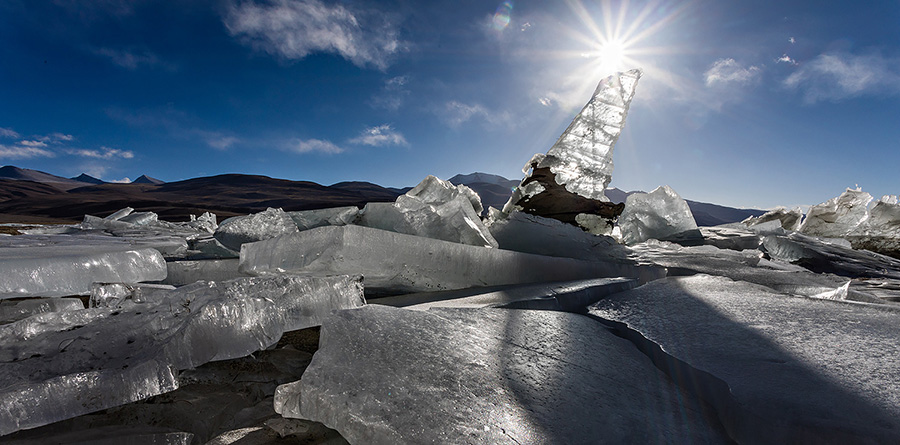
Broken ice-blocks; Tso Moriri lake.
Broken ice-blocks make for interesting imagery in Tso Moriri. In the western-edge of the lake, which is a shallow-end, you often see broken ice-blocks that lift up when the temperatures start getting lower and lower. With the clear winter weather, the sun is always bursting in isolation surrounded by clear blue sky that always makes for a great spectacle.
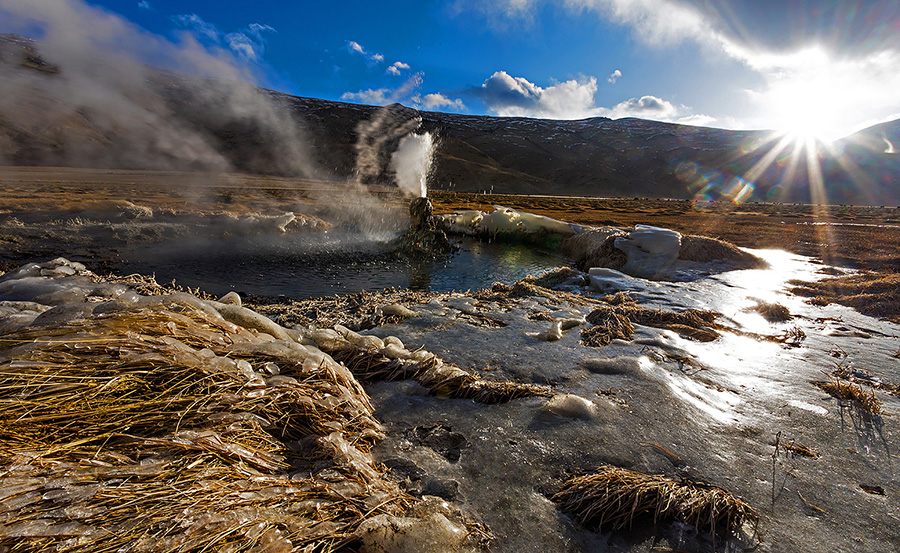
A geyser gushes out of earth, surrounded by ice.
Also found along the grasslands in certain places are geysers, which take on a new life in the winter months. They often form a wall of ice around them, thanks to the cold weather that freezes the water instantly in the night. In other times, the sprinkle of water from the geyser creates interesting formations around them.
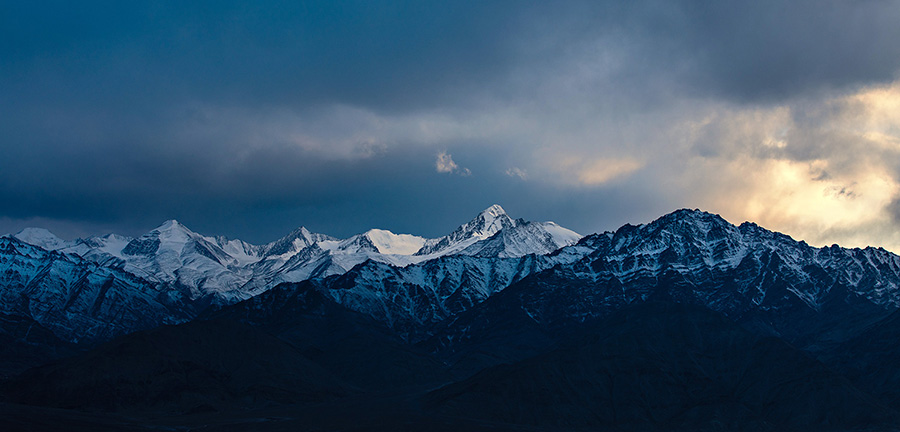
A beautiful winter sunset in Ladakh, when the mountains are covered with more snow than summer time.
For those who are willing to brave the cold, and especially if you are a landscape photography enthusiast, winter in Ladakh can be an exhilarating experience.
Every winter, we conduct a photography tour to see and capture the glorious landscapes of Ladakh. This is perhaps India’s ultimate landscape photography experience. Travel to the highlands of Ladakh in winter, when Ladakh is at its pristine best — with its snow-clad mountain landscapes, frozen lakes, resilient nomads with their herds of sheep and yaks and endless fields of snow. Explore photography on the roof of India on this mentored photography tour in a season when the earth is covered in a carpet of snow. See details and sign up today: A Snow-filled Winter in Ladakh — Photography Tour
